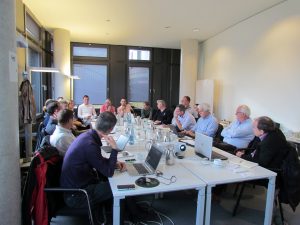The following topics were discussed during the kick-off meeting of SedNet WG Sediments in Circular Economy on November 6th, 2018:
1. Reuse pathways, which, where and how far?
The first question asked by operators and stakeholders is “we would like to reuse dredged sediments instead of dumping,
but which are the technically feasible options, are they acceptable from the regulatory and social point of view, and which is their cost?”
2. Demonstration, Good practice and securing confidence for decision makers
If a reuse option is identified and acceptable, how far has it been used, is it really demonstrated, what are the possible pitfalls, are there any good practice guides ? What is the level of risk involved if we chose Reuse and CE instead of Business as Usual?
3. Markets, SMEs and jobs benefits of sediment reuse
Beyond waste reduction, circular economy development and environmental benefits, EU competitiveness and job creation are major drivers. If the cost-benefit analysis breaks even against disposal, growth, jobs and know-how export will make the difference.
4. The Causal loops approach and sediment reuse
Systemthinking: To change a system (f.i. to improve reuse of sediment) you have to look for underlying root causes. Just like an iceberg, 90% of which is invisible beneath the water, these root causes are often hidden below the surface. However, if you can identify them and connect them to the events that you are seeing, you may be able to develop lasting solutions that target the whole system rather than short term, reactive solutions.
5. Regulations, barrier or incentive for circular approaches?
Reuse meets the Waste status of dredged sediments.
Waste regulations often hamper reuse projects with environmental constraints which were not designed for sediments reuse. They are often country specific and make EU-scale projects even more difficult.
But reuse can provide environmentally beneficial options for site restoration, for river good status (WFD) and for climate change mitigation.
Should regulations evolve to become an incentive for sustainable reuse options?
6. Sediment agglomeration vs aggregate – sustainability?
A large part of dredged sediments is fine-grained or extremely fine grained (clay, mud). In civil engineering applications, there are more needs for coarse sediment or sand than for mud. Mud can be agglomerated to build coarser materials. Agglomeration has a cost (energy, binders,…). A sustainability analysis of this process is needed.
7. Land use benefits of sediment reuse
Reuse options provide land use benefits by:
- The reduction of disposal site surfaces
- The reduction of quarries and sand extraction surfaces
- The restoration of derelict land or of land under flood threats)
Further topics will be addressed in the next meetings.
Back to homepage SedNet WG Sediments in Circular Economy
Participation to this WG is free but registration is mandatory. In order to be informed of the WG activities, please contact the SedNet Secretariat.


